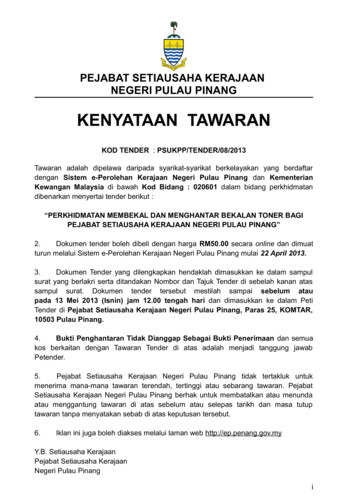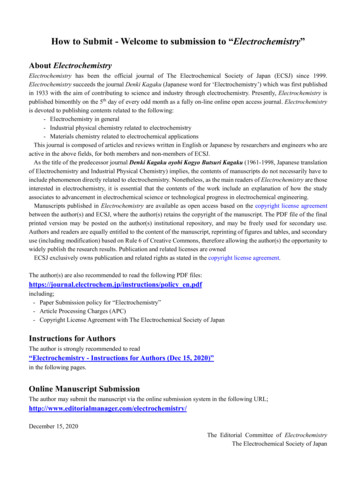Accounting CS: Financial Statement WalkThrough
ACCOUNTING CSFinancial StatementWalkThroughversion 2015.x.x
TL 29625 (12/21/15)Copyright InformationText copyright 2009 - 2015 by Thomson Reuters. All rights reserved.Video display images copyright 2009 - 2015 by Thomson Reuters. All rights reserved.Thomson Reuters hereby grants licensees of CS Professional Suite software the right to reprint this document solely for theirinternal use.Trademark InformationThe trademarks used herein are trademarks and registered trademarks used under license.All other brand and product names mentioned in this guide are trademarks or registered trademarks of their respective holders.
ContentsGetting Started . 1About Accounting CS and the Report Designer . 1Navigating the Report Designer . 2Navigation . 2Report regions . 4Design Tools frame . 4Adding a New Client Record . 5Entering client information manually . 5Downloading the sample spreadsheet . 6Importing data from the sample spreadsheet . 7Modifying Financial Statements . 9Understanding account groupings . 9Opening a predefined financial statement . 11Previewing a predefined financial statement . 11Copying a predefined financial statement . 13Viewing and modifying cell, row, column, and region properties . 14Cell Properties . 14Row Properties . 15Column Properties . 16Region Properties . 17Working in a financial statement . 18Page setup . 18Cell, row, and column setup . 18Cell formatting . 20Accounting CS: Financial Statement WalkThroughiii
ContentsWorking with variables, formulas, functions, and periods . 22Variables . 22Formulas . 24Functions . 25Periods . 27Page breaks . 27Conditional expressions . 28Using the Help & How-To Center . 29ivAccounting CS: Financial Statement WalkThrough
Getting StartedThis walkthrough covers some basic information about the design and functionalityof the Report Designer — specifically to help you produce financial statements.Although it is not intended to show you all of the application features andcapabilities, this walkthrough explains some of the basic features and processes inthe Report Designer. To get the most out of this walkthrough, read the pages insequence and follow along with the documented steps in Accounting CS and theReport Designer.In this chapter, we will: Provide a general overview of Accounting CS and the Report Designer. Explain how to navigate and use the main screen in the Report Designer,including the toolbars, Reports list frame, design grid, and Design Tools frame.About Accounting CS and the Report DesignerAccounting CS combines write-up, trial balance, payroll, financial reporting, andclient accounting functionality into one flexible and customizable platform. Reportingcapabilities in the application let you customize a variety of standard reports,financial statements, and letters that provide value-added analysis for your clients.With the Report Designer, you can: Define report detail at the cell, row, column, or region level. Use repeating levels to group related data, such as account-specific detail in areport. Use variables to create global financial statements that can be used for multipleclients. Set up custom formulas and functions to print calculated values. Use conditional expressions to modify the content that displays in the financialstatement when it is previewed or printed.Accounting CS: Financial Statement WalkThrough1
Getting StartedNavigating the Report DesignerNavigationThe Report Designer enables you to modify reports, financial statements, andletters to fit your specific needs. To begin using the Report Designer effectively, it isimportant that you become familiar with the workspace, which includes the followingcomponents. The Standard toolbar provides quick access to commonly used commandssuch as new report, save, print, print preview, and more. The Current Client toolbar lets you select the client for whom to generate thereports, financial statements, and letters. The Formatting toolbar provides quick access to commonly used formattingtools such as font, font size, font styles, alignment, and more. The Formula bar specifies the content for the selected cell. You can eitherenter a formula or text in the Formula bar or you can click the Insert Formulabutton to build a formula.2 The Reports list frame lists all reports, financial statements, and letters thatare available for your firm and your clients. The design grid is the workspace for building a report, financial statement, orletter. The Design Tools frame enables you to access variables and text formattingcontrols, as well as to specify the cell, row, column, and region properties forthe document.Accounting CS: Financial Statement WalkThrough
Getting StartedStandard toolbarCurrent Client toolbarReports list frameAccounting CS: Financial Statement WalkThroughDesign gridFormatting toolbarFormula barDesign Tools frame3
Getting StartedReport regionsEach report, financial statement, and letter includes at least five regions – header,alternate header, body, footer, and alternate footer. You cannot delete the twoheader and two footer regions. A report, financial statement, or letter can have morethan one region in the body of the document. Each report and financial statement isorganized in a matrix layout similar to other electronic spreadsheets, with horizontalrows and vertical columns.Design Tools frameThe Design Tools frame provides quick access to variables, text formatting, andcell, row, column, and region properties.Note: You can undock the Design Tools frame and move it to other areas on yourdesktop, including to a second monitor. You can also drag-and-drop the frames torearrange them within the Report Designer workspace.Variables. Use variables to insert firm and/or client information into the currentdocument. You can insert variables using one of the following methods. Click the Formula Drag and drop the variable from the Design Tools frame into the appropriatecell. Double-click a variable to insert it into the selected cell.button to use the Formula dialog.Text. The fields in the Text section of the Design Tools frame enable you to quicklyaccess formatting options that are also available in the Format Cells dialog.Properties. When you select a cell, row, column, or region, the Design Tools framedisplays the settings relevant to that selection, such as the contents, grouping type,and grouping content. If you modify settings in a selected row or column of thedesign grid, the change affects all cells in the active selection.4Accounting CS: Financial Statement WalkThrough
Adding a New Client RecordIn Accounting CS, you can set up new client records by manually entering all ofnecessary data or you can use client templates.In this chapter, we will create a new client record that we will use to complete thesteps later in this walkthrough. We will enter some of the client data manually, andthen we will import additional client data from a sample spreadsheet.Entering client information manuallyComplete these steps to create the new client record.1. Choose Setup Clients and then click the Add button.2. In the Add Client dialog:a. Enter ACSFSSC in the ID field.b. Enter Financial Statements Sample Company in the Client name field.c.Select MI from the State drop-down list.d. In the Services section, mark the Accounting checkbox.e. Click the Add button.3. In the Main tab of the Clients screen, enter 12-3456789 in the EIN/SSN field.4. Click the Accounting Information tab and verify or select the following: Select 12/31/2015 from the Current fiscal year end date drop-down list. Select Monthly from the Period frequency drop-down list. Select 12/31/2015 from the Current period end date drop-down list.5. Click the Enter button to save the client record.Accounting CS: Financial Statement WalkThrough5
Adding a New Client RecordDownloading the sample spreadsheetNext, we will import data for our new client from a sample spreadsheet. The samplespreadsheet contains accounts and balances that will create data in the Setup Chart of Accounts screen and the Actions Enter Trial Balance screen.Complete these steps to download the sample spreadsheet from our Help & HowTo Center.1. From the search field on the toolbar in Accounting CS, enter chart of accountsspreadsheet, and then click thebutton.2. Click the Spreadsheet import – Chart of Accounts help topic in the searchresults list.3. In the Sample spreadsheets section of the help topic, click the Chart ofAccounts (with current-year and prior-year balances) link.4. Depending on your browser or internet security settings, you may receive aprompt to Open, Run, or Save the spreadsheet file. Choose Save or Save as todownload the spreadsheet file to the desired location on your computer.6Accounting CS: Financial Statement WalkThrough
Adding a New Client RecordImporting data from the sample spreadsheet1. From any screen in Accounting CS, choose File Import Spreadsheet toopen the Spreadsheet Import Wizard.2. In the Source Data page, select ACSFSSC from the Client name field.3. In the Import Type section, select Chart of Accounts from the Data type dropdown list.4. In the Import File section, click the Browse button, highlight the samplespreadsheet you downloaded, and then click the Open button.5. Click the Next button.Accounting CS: Financial Statement WalkThrough7
Adding a New Client Record6. In the Column Mappings page, complete these steps.a. Map the columns as follows:ColumnMap data asAAccount NumberBAccount GroupingAccount Classification CodeCAccount GroupingAccount Classification SubcodeDAccount DescriptionEUnadjusted Balance12/31/2015Dr/CrFUnadjusted Balance12/31/2014Dr/Crb. Mark the Omit Row checkbox for the first row of spreadsheet data.c.Click the Next button.7. In the Import Options page, select the Append to existing chart and Currentperiod balances options and then click the Import button.8. Review the Import Diagnostics page and click the Finish button.8Accounting CS: Financial Statement WalkThrough
Modifying Financial StatementsAccounting CS provides several predefined financial statements. If none of thepredefined financial statements fit your needs, you can modify them in the ReportDesigner.In this chapter, we will: Explain how the application uses account groupings for financial statementactivity. Locate and open a predefined financial statement. Preview a financial statement. Copy a predefined financial statement to create a new financial statement. Discuss the concepts of Cell, Row, Column, and Region Properties. Modify a financial statement and show formatting capabilities.Understanding account groupingsAccounting CS uses account groupings to group accounts for reporting purposes.The default account grouping is named Account Classification. It includes therequired codes and subcodes that must be set up for every client's Chart ofAccounts to allow the predefined financial statements to work automatically.Let’s take a look at the Account Classification codes and subcodes.1. Choose Setup Account Groupings.2. Select Account Classification from the list on the left.Note that the default codes are in the grid on the left and that the defaultsubcodes (which correspond to the selected code) are in the grid on the right.For example, code CA (Current Assets) contains subcodes of CASH, MS, AR,INV, PE, and OCA.Accounting CS: Financial Statement WalkThrough9
Modifying Financial StatementsNotes You cannot change the codes in the Account Classification account grouping,but you can add subcodes if necessary. You can define additional account groupings for special niche industries, or ifyou need to use different terminology (for example, for use in governmental ornon-profit clients).You can assign Account Classification codes and subcodes in the following areas.10 Setup Chart of Accounts screen Actions Enter Trial Balance screen Edit Edit Multiple Accounts Assign codes dialog (accessed from the Chart ofAccounts screen or the Enter Trial Balance screen)Accounting CS: Financial Statement WalkThrough
Modifying Financial StatementsLet’s take a look at the Account Classification codes and subcodes assigned to anaccount.1. Choose Setup Chart of Accounts.2. Select account 101 (Checking - General) from the list on the left.Note that code CA is selected in the Classification code field and subcodeCASH is selected in the Classification subcode field.Opening a predefined financial statementTo open a predefined financial statement, complete these steps.1. Choose File Report Designer.2. Click the Financial Statements group button in the Reports list frame at thebottom-left.3. Double-click the Balance Sheet - Current Year - Prior Year financialstatement to open it.Previewing a predefined financial statementTo preview a financial statement for a particular client, complete these steps.1. In the Current Client toolbar, verify that ACSFSSC is selected as the currentclient.2. With the Balance Sheet - Current Year - Prior Year financial statement open,choose File Print Preview.3. In the Options dialog, verify the default settings and click OK to preview thefinancial statement.Accounting CS: Financial Statement WalkThrough11
Modifying Financial StatementsThe Print Preview screen provides a quick way to preview financial statements, butit also contains a number of useful tools in the toolbar. Print All Reports. Print all documents included in the print preview. Print. Print the selected document. Copy. Copy the selected document to the clipboard. Find. Search the document for keywords or amounts. Annotations. Insert text, lines, and other annotations to add notes andadditional information. Single or Multiple Page View. Select the number of pages to preview at asingle time. Continuous Scroll. Toggles the continuous scrolling option to browseseamlessly from one page to the next in the print preview. Zoom In/Out. Zoom in or out on the current page. Page Navigation. Browse to the next or previous page, with quick access tothe first and last page of the document. Selected Report. Select a report from the dropdown menu in the upper-rightcorner to preview it.When you finish reviewing the print preview options, close the Print Preview screen.12Accounting CS: Financial Statement WalkThrough
Modifying Financial StatementsCopying a predefined financial statementYou can create a copy of a financial statement in the Report Designer so that youcan customize that copy without altering the original.1. With the Balance Sheet - Current Year - Prior Year financial statement open,choose File Save As.2. In the Save As dialog, enter Balance Sheet - Walkthrough Sample as the filename and click OK.3. The financial statement opens in a new tabbed view in the design grid.Notes As an alternative method, you can right-click a financial statement in theReports list frame and choose the Copy and Paste commands to create a copy. If you customize a predefined financial statement and you want to restore it tothe original version, select the financial statement in the Reports list frame andchoose File Restore Default. You can create custom folders for your clients in the Reports list frame to storeyour client-specific financial statements. For more information, see Associatingcustom folders with clients. Application updates that include changes to financial statements are applied toonly the original predefined financial statements that have not been edited byyour firm.Accounting CS: Financial Statement WalkThrough13
Modifying Financial StatementsViewing and modifying cell, row, column, andregion propertiesDepending on what area of a financial statement is selected in the design grid, oneof the following sections appears in the Design Tools frame – Cell Properties, RowProperties, Column Properties, or Region Properties.Cell PropertiesSelect cell B6 in the design grid to view its Cell Properties. Region. Displays the region thatcorresponds to the currentselection in the design grid. Cell. Displays the cell referencethat corresponds to the selectedcell. Contents. Enter text or click theInsert Formulabutton tocreate and insert a formula intothe selected cell. Grouping type/Groupingcontent. Select the grouping typeand then select the applicablegrouping content. Period. Select the code thatspecifies the time periods fromwhich to pull amounts. Click theSelect Periodbutton to openthe Period dialog to view acomplete list of period indicatorsand to create formulas.14 Amount type. Select the amounttype from which to pull amounts.If no amount type is selected,Balance will be used. Basis. Select the basis fromwhich to pull amounts. If no basisis selected, Adjusted will be used. Segments. Select a segment code or combination of codes from a list ofavailable segments that correspond to the current client. Print distinct values. When marked, it enables variables to repeat only foreach unique instance of the variable data. Print total amount. When marked, it calculates the total amount for an amountvariable that naturally repeats individual amounts. Repeat right. When marked, it i
Accounting CS: Financial Statement WalkThrough 5 Adding a New Client Record In Accounting CS, you can set up new client records by manually entering all of necessary data or you can use client templates. In this chapter, we will create a new client record that we will use to complete the steps later in this walkthrough.
FINANCIAL ACCOUNTING : MEANING, NATURE AND ROLE OF ACCOUNTING STRUCTURE 1.0 Objective 1.1 Introduction 1.2 Origin and Growth of Accounting 1.3 Meaning of Accounting 1.4 Distinction between Book-Keeping and Accounting 1.5 Distinction between Accounting and Accountancy 1.6 Nature of Accounting 1.7 Objectives of Accounting 1.8 Users of Accounting Information 1.9 Branches of Accounting 1.10 Role .
walkthrough and the Q&A. Hopefully I won’t need too many updates. V1.5: Wow, a new version before I’d even finished the walkthrough all the way! I’ve decided to rearrange the way the information was presented, but I haven’t changed any of the content thus far.
prototyping environment, to interact with service components in virtual form and experience the service journey in VR. The VR service walkthrough is based on the service walkthrough prototyping method, which adopted its elements from the methods of experience prototyping, pluralistic walkthrough, and bodystorming (Arvola et al., 2012).
1. What does cost accounting involve? A. Drawing up balance sheet B. Writing off of costs C. Ascertainment of cost D. Preparation of statement of value added E. Annual audit of financial statement 2. Cost accounting is an integral part of A. Financial accounting B. Forensic accounting C. Treasury accounting D. Historical accounting
4 Accounting CS Payroll: WalkThrough Menu commands The menu bar at the top of the screen in Accounting CS Payroll contains several pull-down menus, each of which contain numerous commands. These commands cause Accounting CS Payroll to perform specific functions, such as opening a particular screen.
Accounting Principles Generally Accepted Accounting Principles (GAAP) are the standard framework of guidelines for financial accounting/preparation of financial statements which has strong tight with the common accounting practices along with the accounting standards. Accounting principles are same as accounting concepts which discussed earlier.
Modifying Financial Statements Workpapers CS: Financial Statement WalkThrough 11 Let’s take a look at the Account Classification codes and subcodes assigned to an account. 1. Choose Setup Chart of Accounts. 2. Select ac
Introduction to Digital Logic with Laboratory Exercises 6 A Global Text. This book is licensed under a Creative Commons Attribution 3.0 License Preface This lab manual provides an introduction to digital logic, starting with simple gates and building up to state machines. Students should have a solid understanding of algebra as well as a rudimentary understanding of basic electricity including .























